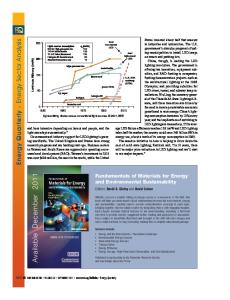Solid-State Lighting
- PDF / 997,517 Bytes
- 13 Pages / 582 x 780 pts Page_size
- 106 Downloads / 408 Views
lid-State Lighting Colin J. Humphreys (Cambridge University, UK) Abstract Electricity generation is the main source of energy-related greenhouse gas emissions and lighting uses one-fifth of its output. Solid-state lighting using light-emitting diodes (LEDs) is poised to reduce this value by at least 50%, so that lighting will then use less than one-tenth of all electricity generated. LED lighting will provide reductions of at least 10% in fuel consumption and carbon dioxide emissions from power stations within the next 5–10 years. Even greater reductions are likely on a 10–20-year timescale.
Electrical Appliances, Lighting, and Energy
At first sight, a 100-W incandescent light bulb might not seem to be a key target for energy savings. An electric oven can consume much more electricity, up to 5,000 W, as can an electric clothes dryer. A window-unit air conditioner uses typically 1000 W; a four-slot toaster, 1500 W; a desktop computer plus monitor, 200 W; and a 19-in. (48-cm) television, 70 W. However, the average house in the United States has 45 light bulbs; in Canada, 30; and in the United Kingdom, 25. Considering a house with 30 light bulbs rated at 100 W and assuming that the bulbs are all of the incandescent type (a heated tungsten wire in a vacuum bulb), then 3,000 W is used to light the house. In addition, the average light bulb is switched on for 4 h per day, so lighting a house consumes about 12 kilowatt-hours (kWh) of electricity per day. By comparison, an electric toaster is likely to be switched on for only a few minutes each day, so it consumes only about 0.1 kWh per day. Taking all buildings together (residential, industrial, and commercial), lighting is the second largest user of energy in buildings.1 Not only does lighting consume a significant amount of energy, it is also extremely inefficient. Incandescent light bulbs convert about 5% of the electricity they use into visible light. Even energy-saving compact fluorescent lamps (a phosphorcoated gas discharge tube) are only about 20% efficient. These low efficiencies contrast starkly with the efficiencies of most of the household appliances just mentioned. For example, electric ovens, clothes dryers, and toasters convert electricity to useful heat with a typical efficiency of at least 70%. Electric motors for fans are typically 90% efficient. There is therefore much more potential for large energy savings from lighting than from most other appliances. Indeed, lighting is so inefficient, and it consumes so much energy, that there is probably more potential for large energy savings in this field than in any other area.
one million million watts).2 Thirty-eight percent of that energy was consumed as electricity, and of that, 22%, or 765 TWh, was consumed by lighting.2 Thus, over 8% of total energy consumption in the United States was for lighting: this is a significant fraction. At $0.068/kWh, the average cost of electricity in the United States in 2001, the electricity cost to end users was about $53 billion.2 (It should be noted that the cost of elec
Data Loading...











